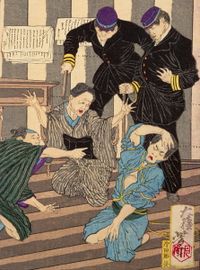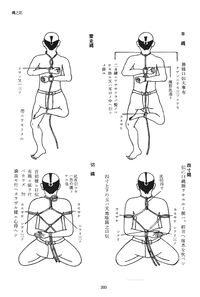Difference between revisions of "Hojojutsu"
| (18 intermediate revisions by 3 users not shown) | |||
| Line 1: | Line 1: | ||
| − | + | [https://smpedia.com/index.php?title=捕縄術 捕縄術](Japanese) | |
| − | == | + | {| align="right" |
| − | Hojojutsu, | + | |- |
| + | |[[image:Hojojutsu1.jpg|200px|thumb|From Yūbin Hōchi Shinbun 484. Art by [[Yoshitoshi Tsukioka]].]] | ||
| + | |- | ||
| + | |<div align="center"; width="200";>__TOC__</div> | ||
| + | |} | ||
| + | <div style="text-align: justify;”> | ||
| + | '''Hojojutsu''' (aka Torinawajutsu) is the Art of Rope Capture. Originally developed as a part of Jujutsu during the Warring States period of Japan, it was later adapted as a method to capture, restrain and control criminals during the Edo period. In the Meiji period, Hojojutsu was inherited by Metropolitan Police Departments. In the twentieth century, it has also provided great influence on the development of erotic SM play in Japan up until today. | ||
| + | </div> | ||
| + | |||
| + | ==Description== | ||
| + | '''Hojojutsu''' has two main divisions. The first is called ''Hayanawa'' (''Fast Binding'') and is used for the capture and restraint of a resisting opponent. The second is called ''Honnawa'' (''Formal Binding''<ref>According to ''[[Zukai Hojojutsu]]'' by Seiko Fujita, ''Hon'' is an abbreviation of ''honshiki''.</ref>) and is used for the transport, escort and punishment of a prisoner. | ||
==History== | ==History== | ||
| − | ===Warring States Period (15th-17th centuries) | + | [[image:Hojojutsu2.jpg|200px|thumb|From [[Zukai Hojojutsu]] by Seiko Fujita (1995)]] |
| + | ===Warring States Period=== | ||
| + | (15th-17th centuries) | ||
| − | ===Edo Period (1603 - 1868)=== | + | During a period when centralized imperial control collapses and regional domains fight for control of the country. |
| + | |||
| + | 1532: Takenouchi jujutsu school is founded, and it teaches rope capture among its techniques. It has been credited as the first hojojutsu school. | ||
| + | |||
| + | ===Edo Period=== | ||
| + | (1603 - 1868) | ||
| + | |||
| + | As Japan is pacified and brought under the authority of the Tokugawa shogunate in the early decades of the 1600s, '''hojojutsu''' moves into law enforcement in the larger towns and cities. | ||
| + | |||
| + | ===Meiji Period=== | ||
| + | (1868 - 1912) | ||
| + | |||
| + | After a struggle between forces claiming loyalty to the emperor and those loyal to the Tokugawa, the Tokugawa shogunate is brought to an end and a new government is established. Law enforcement practice is reorganized along European models, and '''hojojutsu''' gradually becomes more simplified and limited in use. | ||
| + | |||
| + | 1874: Japan establishes a European-style civil police force. | ||
| + | |||
| + | |||
| + | === Taisho Period === | ||
| + | (1912-1926) | ||
| + | |||
| + | |||
| + | |||
| + | === Showa Period === | ||
| + | (1926 - 1989) | ||
| − | |||
| − | |||
=== 21st Century === | === 21st Century === | ||
| + | '' '' | ||
| + | |||
| + | |||
| + | == Hojojutsu Influence on Kinbaku == | ||
| + | After the war, many kinbakushis, such as [[Takashi Tsujimura]], [[Chimuo Nureki]], and [[Denki Akechi]], developed their bondage styles by referencing techniques from '''hojojutsu'''. In other words, while '''hojojutsu''' certainly influenced SM during the Showa period, SM in that era did not originate from '''hojojutsu'''. The pioneer of SM in the Showa period, [[Seiu Ito]], commenced SM activities during the Taisho period, raising the question of how much '''hojojutsu''' influenced Ito. None of the documents record that [[Seiu Ito]] examined '''hojojutsu''', but numerous post-war publications, such as plays, illustrations, and novels, clearly reflect similar interests and knowledge of torment that extend from '''hojojutsu''', as well as public punishment in the Edo period. However, ''“[[Discussions on Torment]]”'' (1929), written by [[Seiu Ito]] after the start of SM activities, discussed the difference between torment and torture without mentioning '''hojojutsu''' in the context. In the post-war revision of ''“Discussions on Torment”'' (1952), Ito drew a sharp distinction between female bondage in public punishment and private torment for personal sexual pleasure. The origin of SM is profoundly influenced by plays, paintings, and novels rather than '''hojojutsu''', especially considering that [[Seiu Ito]] had a strong interest in works depicting torment scenes since childhood. The depictions of torment in plays, illustrations, and novels suggest the influence of '''hojojutsu'''; however, “torment” has existed since ancient times, reflected in folklore and literary motifs such as “Princess Anju.”<ref> [[Takatekote]] is mentioned in the story. [https://dl.ndl.go.jp/pid/926050/1/152 ''"Literary Materials of the Edo Period"''] is the earliest written record from the 17th century by Hishikawa Moronobu.</ref> | ||
| + | |||
| + | |||
| + | |||
| + | ==Hojojutsu in Literature == | ||
| + | * ''Eigoro Omaeda'' (1921) | ||
| + | |||
| + | * ''Female Ninja Detective Diaries'' (1973) Manga | ||
| + | |||
| + | |||
| + | ==Hojojutsu in Art== | ||
| + | <div style="font-size:125%";>'''Illustrations and Prints'''</div> | ||
| + | |||
| + | |||
| + | ==Hojojutsu in Movies== | ||
| + | * ''Zenigata Heiji Detective Story: Heiji Covers All of Edo'' (1949) | ||
| + | |||
| + | * ''Zenigata Heiji Torimono Hikae: Bijin-gumo'' (1960) | ||
| + | |||
| + | |||
| + | ==Hojojutsu in Television== | ||
| + | '' '' | ||
| + | |||
| + | |||
| + | == Selected Works == | ||
| + | * The Pictorial Book on the Penal Affairs of the Tokugawa Government (1893)<ref>This famous propaganda book (printed in Japanese and English) promotes the criminal justice advances of the Meiji government. Color images from this book are widespread and often appear in internet sites that mention hojojutsu.</ref> | ||
| + | |||
| + | * Mura, Inokichi. ''Torinawa Teaching Manual'' (1926) | ||
| + | |||
| + | * Mizukoshi, Hiro. Torinawajutsu (2006) | ||
| + | |||
| + | * Itatsu, Kazuhiko. ''Ittatsu-Ryu Hojo-Jutsu (2011) | ||
| + | |||
| + | |||
| − | |||
| − | |||
==Notes== | ==Notes== | ||
| − | <references group=" | + | <references/> |
| + | ==References (※)== | ||
| + | <references group="※"/> | ||
==External Links== | ==External Links== | ||
Latest revision as of 14:21, 2 May 2025
捕縄術(Japanese)
 From Yūbin Hōchi Shinbun 484. Art by Yoshitoshi Tsukioka. |
Hojojutsu (aka Torinawajutsu) is the Art of Rope Capture. Originally developed as a part of Jujutsu during the Warring States period of Japan, it was later adapted as a method to capture, restrain and control criminals during the Edo period. In the Meiji period, Hojojutsu was inherited by Metropolitan Police Departments. In the twentieth century, it has also provided great influence on the development of erotic SM play in Japan up until today.
Description
Hojojutsu has two main divisions. The first is called Hayanawa (Fast Binding) and is used for the capture and restraint of a resisting opponent. The second is called Honnawa (Formal Binding[1]) and is used for the transport, escort and punishment of a prisoner.
History

Warring States Period
(15th-17th centuries)
During a period when centralized imperial control collapses and regional domains fight for control of the country.
1532: Takenouchi jujutsu school is founded, and it teaches rope capture among its techniques. It has been credited as the first hojojutsu school.
Edo Period
(1603 - 1868)
As Japan is pacified and brought under the authority of the Tokugawa shogunate in the early decades of the 1600s, hojojutsu moves into law enforcement in the larger towns and cities.
Meiji Period
(1868 - 1912)
After a struggle between forces claiming loyalty to the emperor and those loyal to the Tokugawa, the Tokugawa shogunate is brought to an end and a new government is established. Law enforcement practice is reorganized along European models, and hojojutsu gradually becomes more simplified and limited in use.
1874: Japan establishes a European-style civil police force.
Taisho Period
(1912-1926)
Showa Period
(1926 - 1989)
21st Century
Hojojutsu Influence on Kinbaku
After the war, many kinbakushis, such as Takashi Tsujimura, Chimuo Nureki, and Denki Akechi, developed their bondage styles by referencing techniques from hojojutsu. In other words, while hojojutsu certainly influenced SM during the Showa period, SM in that era did not originate from hojojutsu. The pioneer of SM in the Showa period, Seiu Ito, commenced SM activities during the Taisho period, raising the question of how much hojojutsu influenced Ito. None of the documents record that Seiu Ito examined hojojutsu, but numerous post-war publications, such as plays, illustrations, and novels, clearly reflect similar interests and knowledge of torment that extend from hojojutsu, as well as public punishment in the Edo period. However, “Discussions on Torment” (1929), written by Seiu Ito after the start of SM activities, discussed the difference between torment and torture without mentioning hojojutsu in the context. In the post-war revision of “Discussions on Torment” (1952), Ito drew a sharp distinction between female bondage in public punishment and private torment for personal sexual pleasure. The origin of SM is profoundly influenced by plays, paintings, and novels rather than hojojutsu, especially considering that Seiu Ito had a strong interest in works depicting torment scenes since childhood. The depictions of torment in plays, illustrations, and novels suggest the influence of hojojutsu; however, “torment” has existed since ancient times, reflected in folklore and literary motifs such as “Princess Anju.”[2]
Hojojutsu in Literature
- Eigoro Omaeda (1921)
- Female Ninja Detective Diaries (1973) Manga
Hojojutsu in Art
Hojojutsu in Movies
- Zenigata Heiji Detective Story: Heiji Covers All of Edo (1949)
- Zenigata Heiji Torimono Hikae: Bijin-gumo (1960)
Hojojutsu in Television
Selected Works
- The Pictorial Book on the Penal Affairs of the Tokugawa Government (1893)[3]
- Mura, Inokichi. Torinawa Teaching Manual (1926)
- Mizukoshi, Hiro. Torinawajutsu (2006)
- Itatsu, Kazuhiko. Ittatsu-Ryu Hojo-Jutsu (2011)
Notes
- ↑ According to Zukai Hojojutsu by Seiko Fujita, Hon is an abbreviation of honshiki.
- ↑ Takatekote is mentioned in the story. "Literary Materials of the Edo Period" is the earliest written record from the 17th century by Hishikawa Moronobu.
- ↑ This famous propaganda book (printed in Japanese and English) promotes the criminal justice advances of the Meiji government. Color images from this book are widespread and often appear in internet sites that mention hojojutsu.
References (※)